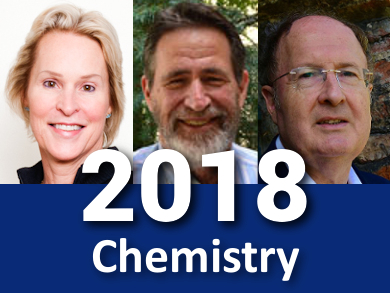The Nobel Prize in Chemistry 2018 has been awarded with one half to
- Frances H. Arnold (pictured left), California Institute of Technology (Caltech), Pasadena, USA,
“for the directed evolution of enzymes”
and the other half jointly to
- George P. Smith (pictured center), University of Missouri, Columbia, USA, and
- Sir Gregory P. Winter (pictured right), MRC Laboratory of Molecular Biology, Cambridge, UK,
“for the phage display of peptides and antibodies.”
The researchers have taken control of evolution and used it to produce enzymes that can manufacture, e.g., biofuels or pharmaceuticals, as well as antibodies that can combat, e.g., autoimmune diseases or cancer.
Frances H. Arnold conducted the first directed evolution of enzymes in 1993. She tried to change the enzyme subtilisin to catalyze chemical reactions in an organic solvent instead of water. She created mutations in the enzyme’s genetic code and then used bacteria to produce thousands of different variants of subtilisin. She then selected the variant of subtilisin that was most effective in an organic solvent. This variant was subjected to mutations again, and after several “generations”, a useful enzyme for the desired purpose had been created. Such methods, which rely on evolution instead of “rational” human design, are now routinely used to develop new catalysts.
George Smith developed a method known as “phage display” in 1985. The approach uses a bacteriophage—a virus that infects bacteria. Bacteriophages reproduce by injecting their genetic material into bacteria and “hijacking” the bacteria’s metabolism. The bacteria then produce new copies of the proteins that form the phage’s capsule and of the phage’s genetic material, which is stored in this capsule. Smith’s idea was that the phages could be used to study genes whose function was unknown. Such genes could be put together with the gene for one of the proteins in the phage capsule. When new phages were produced, the proteins from the unknown gene would end up on the surface of the phage. Antibodies could then be used to identify known proteins among the products and figure out the function of the unknown gene.
Starting in 1990, Gregory Winter used phage display for the directed evolution of antibodies with the aim of producing new pharmaceuticals. Previously, antibodies for pharmaceutical applications had been produced in mice, which limited their usefulness. Winter joined the genetic information for an antibody to the gene for one of the phage’s capsule proteins. This led to the antibody’s binding site ending up on the surface of the phage. He built a library of phages with billions of varieties of antibodies on their surfaces and selected those that bound to certain target proteins. Cycles of mutation and selection then led to the evolution of useful antibodies for the desired application. Phage display has produced antibodies that can neutralize toxins, counteract autoimmune diseases, and cure some metastatic cancers.
Frances H. Arnold, born in 1956 in Pittsburgh, USA, received her Ph.D. in 1985 from the University of California, Berkeley, USA. She performed postdoctoral research in biophysical chemistry there before joining Caltech in 1986. Today, she is the Linus Pauling Professor of Chemical Engineering, Bioengineering and Biochemistry at Caltech. Among many other awards, she has received the 2011 Draper Prize, the U.S. National Medal of Technology and Innovation in 2013, the Emanuel Merck Lectureship 2013, and the Millennium Technology Prize in 2016. She is a Member of the U.S. National Academy of Sciences, of the U.S. National Academy of Engineering, and of the U.S. Institute of Medicine. Among other commitments, she serves as a Member of the Editorial Advisory Boards of Angewandte Chemie and ChemBioChem.
George P. Smith, born in 1941 in Norwalk, USA, received his Ph.D. in 1970 from Harvard University, Cambridge, MA, USA. He performed postdoctoral research at the University of Wisconsin-Madison, USA, and joined the University of Missouri in 1975. Today, he is Curators’ Distinguished Professor Emeritus of Biological Sciences at the University of Missouri. Among other honors, he has received the Promega Biotechnology Research Award in 2007. He is an Elected Fellow of the American Association for the Advancement of Science (AAAS).
Sir Gregory P. Winter, born in 1951 in Leicester, UK, received his Ph.D. in 1976 from the University of Cambridge, UK. He also performed postdoctoral research there. Today, he is Research Leader Emeritus at the MRC Laboratory of Molecular Biology. Among other honors, he has received the Scheele Award in 1994, the Royal Medal from the Royal Society in 2011, and the Prince of Asturias Award in 2012. He was appointed Commander of the Order of the British Empire (CBE) in 1997 and is a Fellow of the Royal Society.
Selected Publications by Frances H. Arnold
- Tuning the activity of an enzyme for unusual environments: sequential random mutagenesis of subtilisin E for catalysis in dimethylformamide.,
K. Chen, F. H. Arnold,
Proc. Natl. Acad. Sci. 1993, 90, 5618–5622.
https://doi.org/10.1073/pnas.90.12.5618 - Engineered Bacterial Mimics of Human Drug Metabolizing Enzyme CYP2C9,
A. Rentmeister, T. R. Brown, C. D. Snow, M. N. Carbone, F. H. Arnold,
ChemCatChem 2011, 3, 1065–1071.
https://doi.org/10.1002/cctc.201000452 - Enantioselective Intramolecular C–H Amination Catalyzed by Engineered Cytochrome P450 Enzymes In Vitro and In Vivo,
J. A. McIntosh, P. S. Coelho, C. C. Farwell, Z. J. Wang, J. C. Lewis, T. R. Brown, F. H. Arnold,
Angew. Chem. Int. Ed. 2013, 52, 9309–9312.
https://doi.org/10.1002/anie.201304401 - Non-natural Olefin Cyclopropanation Catalyzed by Diverse Cytochrome P450s and Other Hemoproteins,
T. Heel, J. A. McIntosh, S. C. Dodani, J. T. Meyerowitz, F. H. Arnold,
ChemBioChem 2014, 15, 2556–2562.
https://doi.org/10.1002/cbic.201402286 - Expanding the Enzyme Universe: Accessing Non-Natural Reactions by Mechanism-Guided Directed Evolution,
H. Renata, Z. J. Wang, F. H. Arnold,
Angew. Chem. Int. Ed. 2015, 54, 3351–3367.
https://doi.org/10.1002/anie.201409470 - Directed Evolution: Bringing New Chemistry to Life,
F. H. Arnold,
Angew. Chem. Int. Ed. 2018, 57, 4143–4148.
https://doi.org/10.1002/anie.201708408
Selected Publications by George P. Smith
- Filamentous fusion phage: novel expression vectors that display cloned antigens on the virion surface,
G. Smith,
Science 1985, 228, 1315–1317.
https://doi.org/10.1126/science.4001944 - Antibody-selectable filamentous fd phage vectors: affinity purification of target genes,
S. F. Parmley, G. P. Smith,
Gene 1988, 73, 305–318.
https://doi.org/10.1016/0378-1119(88)90495-7 - Corruption of phage display libraries by target-unrelated clones: Diagnosis and countermeasures,
W. D. Thomas, M. Golomb, G. P. Smith,
Anal. Biochem. 2010, 407, 237–240.
https://doi.org/10.1016/j.ab.2010.07.037 - Engineering filamentous phage carriers to improve focusing of antibody responses against peptides,
N. E. van Houten, K. A. Henry, G. P. Smith, J. K. Scott,
Vaccine 2010, 28, 2174–2185.
https://doi.org/10.1016/j.vaccine.2009.12.059 - Affinity Maturation of an ERBB2-Targeted SPECT Imaging Peptide by In Vivo Phage Display,
B. M. Larimer, W. D. Thomas, G. P. Smith, S. L. Deutscher,
Mol. Imaging Biol. 2014, 16, 449–458.
https://doi.org/10.1007/s11307-014-0724-5 - In Vivo Bacteriophage Peptide Display to Tailor Pharmacokinetics of Biological Nanoparticles,
J. R. Newton-Northup, M. T. Dickerson, S. R. Kumar, G. P. Smith, T. P. Quinn, S. L. Deutscher,
Mol. Imaging Biol. 2014, 16, 854–864.
https://doi.org/10.1007/s11307-014-0762-z
Selected Publications by Sir Gregory P. Winter
- Analysis of Enzyme Structure and Activity by Protein Engineering,
A. R. Fersht, J.-P. Shi, A. J. Wilkinson, D. M. Blow, P. Carter, M. M. Y. Waye, G. P. Winter,
Angew. Chem. Int. Ed. Engl. 1984, 23, 467–473.
https://doi.org/10.1002/anie.198404673 - Phage antibodies: filamentous phage displaying antibody variable domains,
J. McCafferty, A. D. Griffiths, G. P. Winter, D. J. Chiswell,
Nature 1990, 348, 552–554.
https://doi.org/10.1038/348552a0 - By-passing immunisation: Human antibodies from synthetic repertoires of germline VH gene segments rearranged in vitro,
H. R. Hoogenboom, G. P. Winter.
J. Mol. Biol. 1992, 227, 381–388.
https://doi.org/10.1016/0022-2836(92)90894-P - A Method for the Selection of Catalytic Activity Using Phage Display and Proximity Coupling,
J.‐L. Jestin, P. Kristensen, G. P. Winter,
Angew. Chem. Int. Ed. 1999, 38, 1124–1127.
https://doi.org/10.1002/(SICI)1521-3773(19990419)38:8<1124::AID-ANIE1124>3.0.CO;2-W - Phage-encoded combinatorial chemical libraries based on bicyclic peptides,
C. Heinis, T. Rutherford, S. Freund, G. P. Winter,
Nat. Chem. Biol. 2009, 5, 502–507.
https://doi.org/10.1038/nchembio.184 - Bicyclic Peptides with Optimized Ring Size Inhibit Human Plasma Kallikrein and its Orthologues While Sparing Paralogous Proteases,
V. Baeriswyl, H. Rapley, L. Pollaro, C. Stace, D. Teufel, E. Walker, S. Chen, G. P. Winter, J. Tite, C. Heinis,
ChemMedChem 2012, 7, 1173–1176.
https://doi.org/10.1002/cmdc.201200071
Also of Interest
- Nobel Prize in Physiology or Medicine 2018,
ChemViews Mag. 2018.
The prize was awarded to James P. Allison and Tasuku Honjo for their discovery of cancer therapy by inhibition of negative immune regulation - Nobel Prize in Physics 2018,
ChemViews Mag. 2018.
The prize was awarded to Arthur Ashkin, Gérard Mourou, and Donna Strickland for groundbreaking inventions in the field of laser physics - Nobel Prize in Chemistry 2017,
ChemViews Mag. 2017.
The prize was awarded to J. Dubochet, Switzerland, J. Frank, USA, and R. Henderson, UK, for imaging molecules live - The Nobel Prize,
Veronika Belusa,
ChemViews Mag. 2015.
Collection of information on the Nobel Prize - Frances Arnold Awarded Emanuel Merck Lectureship 2013,
ChemViews Mag. 2013.
Professor Frances Arnold, Caltech, USA, has been awarded the Emanuel Merck Lectureship and will deliver a special public lecture - Prince of Asturias Award for R. Lerner and G. Winter,
Jonathan Faiz,
ChemViews Mag. 2012.
Gregory Winter, UK, and Richard Lerner, USA, receive the Prince of Asturias Award for their work on antibodies and immunology - Interview with Frances H. Arnold — Design by Evolution,
Vera Köster,
ChemViews Mag. 2011.
https://doi.org/10.1002/chemv.201000143
Caltech Professor Frances H. Arnold sees laboratory evolution designing biology as solution to human problems




